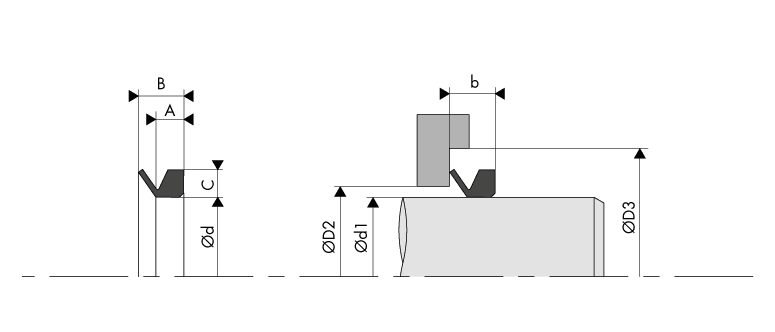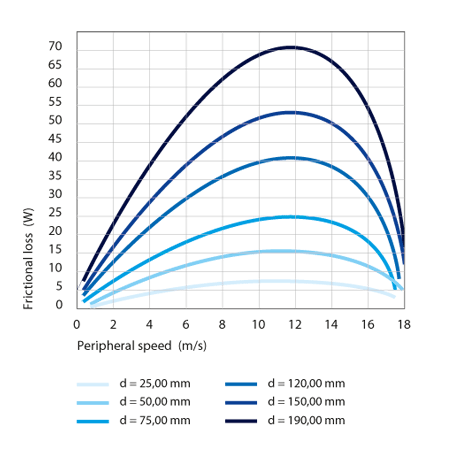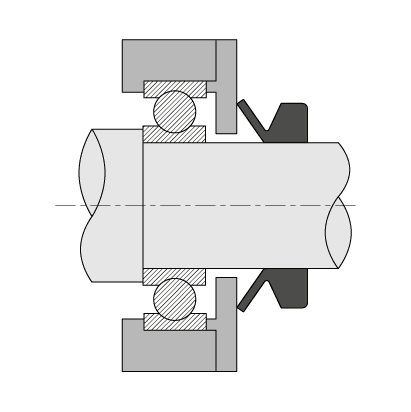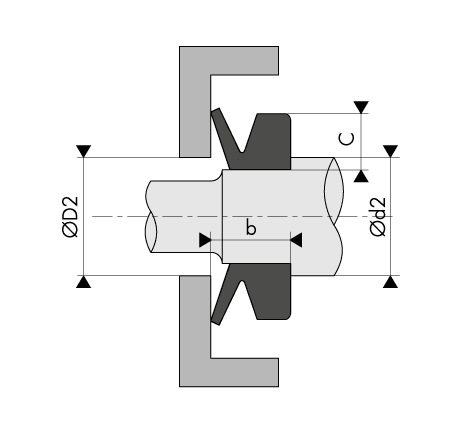BECA 120VL



Description
The BECA 120VL profile is a rubber facial effect V'Ring.
Advantages
Excellent chemical compatibility and wide temperature range, depending on the type of material chosen
Low friction
Good elasticity
Suitable for confined spaces, substituting labyrinth seals
Technical data
| Temperature | -30°C/+200°C |
|---|---|
| Speed | 10 m/s |
Applications
General industry
Materials
NBR 60 - 70 Shore A
FKM 60 - 70 Shore A
Dimensions

Materials
ACM (Polyacrylate)
Polymers containing ethyl acrylate (or butyl acrylate) have a small amount of monomer, which is necessary for cross-linking; ACM is a material with better heat resistance than NBR. It is often used for automatic gearboxes.
| Chemical resistance | Mineral oils (motor oils, gear box oils, ATF oils) Atmospheric and ozone agents |
|---|---|
| Compatibility issue | Glycol-based brake fluids (Dot 3 & 4) Aromatic and chlorinated hydrocarbons Water and steam Acids, alkalis and amines |
| Temperature range | -25°C to + 150°C (short-term peak at +160°C) -35°C / +150°C with particular ACMs |
AEM (ethylene acrylate rubber)
As a methyl acrylate and ethylene copolymer, AEM is considered to be more resistant to heat than ACM. Its characteristics make it an intermediary between ACM and FKM.
| Chemical resistance | Cooling fluids Aggressive mineral oils Atmospheric agents Water |
|---|---|
| Compatibility issue | Aromatic solvents Strong acids Brake fluids Gearbox oils ATF oils |
| Temperature range | - 40°C to + 150°C |
CR (Polychloroprene)
This CR-based rubber is used in the refrigeration industry and for ventilation systems. This chloroprene was the first synthetic rubber to be developed and marketed.
| Chemical resistance | Paraffinic mineral oils Silicone oils and greases Water and water-based solvents for use at low temperatures Refrigerant fluids Ammoniac Carbon dioxide Atmospheric and ozone agents |
|---|---|
| Limited chemical resistance | Naphthenic mineral oils Aliphatic hydrocarbons (propane, butane, petroleum) Glycol-based brake fluids |
| Compatibility issue | Aromatic hydrocarbons (benzene) Chlorinated hydrocarbons (trichlorethylene) Polar solvents (ketone, acetone, acetic acid, ethylene-ester) |
| Temperature range | -40°C / +100°C (short-term peak at +120°C) |
EPDM (Ethylene Propylene Diene Monomer rubber)
As an Ethylene Propylene Diene Monomer copolymer, EPDM is commonly used for hot water taps, cooling systems, brake systems, dishwashers and washing machines.
| Chemical resistance | Hot water and steam up to +150°C Glycol-based brake fluids (Dot 3 & 4) and silicone-based brake fluids (Dot 5) Organic and inorganic acids Cleaning agents, sodium and potassium alkalis Hydraulic fluids (HFD-R) Silicone oils and greases Polar solvents (alcohols, ketones and esters) Atmospheric and ozone agents |
|---|---|
| Compatibility issue | Mineral oils and greases Hydrocarbons Low impermeability to gas |
| Temperature range | -45°C / +150°C (short-term peak at +175°C) |
FFKM (perfluorinated rubber)
FFKM has the best characteristics for resistance to high temperatures, with an excellent chemical inertia. This FKM-based rubber is very often used for high-temperature hydraulic and pneumatic systems, industrial valves, injection/fuel systems, motor seals and high-vacuum systems.
| Chemical resistance | Aliphatic and aromatic hydrocarbons Polar solvents (ketones, esters and ethers) Organic and inorganic acids Water and steam High-vacuum system |
|---|---|
| Compatibility issue | Coolants (R11, R12, R13, R113, R114, etc.) PFPE |
| Temperature range | -15°C/+320°C |
FKM (fluorinated rubber)
Depending on their structure and fluorine content, the chemical resistance and resistance to the cold in fluororubbers can vary. This FKM-based rubber is very often used for high-temperature hydraulics and pneumatics, for industrial valves, injection/fuel systems, motor seals and high-vacuum systems.
| Chemical resistance | Mineral oils and greases, ASTM n°1, IRM 902 and IRM 903 oils. Fire-resistant liquids (HFD) Silicone oils and greases Mineral and vegetable oils and greases Aliphatic hydrocarbons (propane, butane, petroleum) Aromatic hydrocarbons (benzene, toluene) Chlorinated hydrocarbons (trichlorethylene) Fuel (including high alcohol content) Atmospheric and ozone agents |
|---|---|
| Compatibility issue | Glycol-based brake fluids Ammonia gas Organic acids with a low molecular weight (formic and acetic acids) |
| Temperature range | -20°C / +200°C (short-term peak at +230°C) -40°C / +200°C with particular FKMs |
FVMQ (fluorosilicone rubber)
The FVMQ has mechanical and physical properties that are very similar to those of the VMQ. However, the FVMQ offers better resistance to fuels and mineral oils. However, resistance to hot air is not as good as that of the VMQ.
| Chemical resistance | Aromatic mineral oils (IRM 903 oil) Fuels Aromatic hydrocarbons with low molecular weights (benzene, toluene) |
|---|---|
| Temperature range | -70°C/+175°C |
HNBR (Hydrogenated Nitrile Butadiene Rubber)
This HNBR-based rubber is obtained through selective hydrogenation of the NBR's butadiene groups. It is commonly used for power-assisted steering and for air conditioning.
| Chemical resistance | Aliphatic hydrocarbons Mineral and vegetable oils and greases Fire-resistant fluids (HFA, HFB and HFC) Diluted acids, saline solutions and bases for operation at an average temperature Water and steam up to +150°C Atmospheric and ozone agents |
|---|---|
| Compatibility issue | Chlorinated hydrocarbons Polar solvents (ketones, esters and ethers) Strong acids |
| Temperature range | -30°C / +150°C (short-term peak at +160°C) -40°C / +150°C with particular HNBRs |
NBR (Nitrile Butadiene Rubber)
Nitrile rubber (NBR) is the general term for acrylonitrile-butadiene copolymer. The ACN content can vary between 18% and 50%. While the acrylonitrile content is important, the resistance to oil and fuel is more so. Conversely, the elasticity and compression set are not as good. The NBR has good mechanical properties and good wear resistance. However, its resistance to atmospheric agents and the ozone is relatively low.
| Chemical resistance | Aliphatic hydrocarbons (propane, butane, petroleum, diesel fuel) Mineral oils and greases Fire-resistant fluids (HFA, HFB and HFC) Diluted acids, low-temperature alkaline and saline solutions Water (up to +100°C max) |
|---|---|
| Compatibility issue | Fuels with high aromatic content Aromatic hydrocarbons (benzene) Chlorinated hydrocarbons (trichlorethylene) Polar solvents (ketone, acetone, acetic acid, ethylene-ester) Strong acids Glycol-based brake fluids Atmospheric and ozone agents |
| Temperature range | -30°C / +100°C (short-term peak at +120°C) -40°C / +100°C with particular NBRs |
VMQ (silicone rubber: methyl vinyl polysiloxane)
This FVMQ-based rubber is very often used in fuel systems.
| Chemical resistance | Animal and vegetable oils and greases Water for operation at an average temperature Diluted saline solutions Atmospheric and ozone agents |
|---|---|
| Compatibility issue | Superheated steam up to +120°C Chlorinated hydrocarbons with a low molecular weight (trichlorethylene) Aromatic hydrocarbons (benzene, toluene) |
| Temperature range | -60°C / +200°C (short-term peak at +230°C) |
The table below gives an overview of the physical, chemical and mechanical characteristics for each of the materials.
| Characteristics/Materials | ACM | AEM | CR | EPDM | FFKM | FKM | FVMQ | HNBR | NBR | VMQ |
|---|---|---|---|---|---|---|---|---|---|---|
| Abrasion resistant | 2 | 3 | 2 | 2 | 4 | 2 | 4 | 2 | 2 | 4 |
| Resistance to acids | 4 | 3 | 2 | 2 | 1 | 1 | 3 | 1 | 3 | 3 |
| Chemical resistance | 4 | 2 | 2 | 1 | 1 | 1 | 1 | 2 | 2 | 2 |
| Resistance to cold | 4 | 2 | 2 | 2 | 3 | 4 | 2 | 2 | 2 | 2 |
| Dynamic properties | 3 | 3 | 3 | 2 | 3 | 2 | 4 | 1 | 2 | 4 |
| Electrical properties | 3 | 3 | 3 | 2 | 1 | 4 | 1 | 3 | 3 | 1 |
| Flame resistant | 4 | 4 | 2 | 4 | 1 | 1 | 2 | 4 | 4 | 3 |
| Heat resistant | 1 | 1 | 2 | 2 | 1 | 1 | 1 | 1 | 2 | 1 |
| Sealing water | 1 | 1 | 2 | 2 | 2 | 2 | 4 | 2 | 2 | 4 |
| Oil resistant | 1 | 3 | 2 | 4 | 1 | 1 | 2 | 1 | 1 | 2 |
| Ozone resistant | 1 | 1 | 2 | 1 | 1 | 1 | 1 | 2 | 4 | 1 |
| Tearing resistant | 2 | 3 | 3 | 1 | 4 | 3 | 4 | 2 | 2 | 4 |
| Traction resistant | 3 | 2 | 2 | 1 | 2 | 1 | 3 | 1 | 2 | 4 |
| Water/vapour resistant | 4 | 4 | 3 | 1 | 2 | 3 | 3 | 1 | 2 | 3 |
| Resistance to atmospheric agents | 1 | 1 | 1 | 1 | 1 | 1 | 1 | 2 | 3 | 1 |
1. Excellent properties 2. Good properties 3. Average properties 4. Poor properties
Chemical compatibility
A "Chemical compatibility guide" catalogue can be downloaded from the Documentation section. You can also use our online "Chemical compatibility" tool free of charge.
These two tools give you the option of measuring the behaviour of our materials that come into contact with the majority of existing fluids. The data displayed is the result of rigorous testing of the ambient temperature and in consultation with previous publications. Test results are not fully representative due to the specific features of your application. The tests performed actually do not consider additives and impurities that may exist under the actual conditions of use, nor the potential elevation of temperatures. Other parameters can also alter the behaviour of our materials, such as the hardness, persistence, abrasion, etc. We therefore recommend performing your own tests to verify the compatibility of our materials according to your specific application. Our technical team can provide you with any additional information.
Technical data

Loss of power
The sealing lip of a V'Ring exerts such a low pressure on the contact surface area that the loss of power resulting from it is also low. The variations in power loss depend on the circumferential speed as well as the diameter of the axis in rotation, as shown in the graph below. At speeds greater than 11.0 m/s, the sealing lip has a tendency to detach itself, as the centrifugal force is greater.

Shaft design
Considering that the V'Ring is fitted and tightened by expansion on the shaft, it is driven into rotation with the shaft. The requirements of tolerances and surface conditions (Ra ≤ 3.2 µm) are relatively moderate. We recommend carefully selecting the size using the dimensional chart for applications in which power loss and V'Ring lifespan are important criteria. If the diameter of the shaft Ød1 overlaps two potential V'Ring choices, we recommend selecting the larger V'Ring. The tightness on the shaft will in fact reduce, like the contact pressure of the lip on the back.
Counter-face design

Surface roughness
| Roughness in Ra | Circumferential speed v | Media |
|---|---|---|
| 0.40 µm - 0.80 µm | > 10.0 m/s | Oil, water |
| 0.80 µm - 1.60 µm | 5.0 m/s - 10.0 m/s | Oil splashes, grease, water splashes |
| 1.60 µm - 2.00 µm | 1.0 m/s - 5.0 m/s | Grease, dirt, water splashes |
| 2.00 µm - 2.50 µm | < 1.0 m/s | Grease, dirt |
The surface roughness must not have a Ra < 0.05 µm.
Flatness
The flatness of the counter-face is essential, even more so when rotation speeds are high. The maximum acceptable deviation is 0.40 mm for 100.00 mm.
Axial support

Installing the V'Ring is recommended when the axial support is at full stop. This is also recommended for applications where tightening between the V'Ring and the shaft is relatively weak and where the circumferential speed will exceed 6.0 - 8.0 m/s.
The table below sets out the calculation method for the diameter of the support Ød2.
| V'Ring profiles | Diameter Ød2 |
|---|---|
| BECA 120VA |
Ød1 + 0.50 x C |
| BECA 120VE |
Ød1 + 9.00 mm |
| BECA 120VL |
Ød1 + 3.00 mm |
| BECA 120VS |
Ød1 + 0.50 x C |
|
120.VL130
|
125,0 - 135,0 | 117,00 | 10,50 | 6,50 | 6,00 | 8,0 ± 1,5 | d1 + 5,0 | d1 + 20,0 |
|
120.VL140
|
135,0 - 145,0 | 126,00 | 10,50 | 6,50 | 6,00 | 8,0 ± 1,5 | d1 + 5,0 | d1 + 20,0 |
|
120.VL150
|
145,0 - 155,0 | 135,00 | 10,50 | 6,50 | 6,00 | 8,0 ± 1,5 | d1 + 5,0 | d1 + 20,0 |
|
120.VL160
|
155,0 - 165,0 | 144,00 | 10,50 | 6,50 | 6,00 | 8,0 ± 1,5 | d1 + 5,0 | d1 + 20,0 |
|
120.VL170
|
165,0 - 175,0 | 153,00 | 10,50 | 6,50 | 6,00 | 8,0 ± 1,5 | d1 + 5,0 | d1 + 20,0 |
|
120.VL180
|
175,0 - 185,0 | 162,00 | 10,50 | 6,50 | 6,00 | 8,0 ± 1,5 | d1 + 5,0 | d1 + 20,0 |
|
120.VL200
|
195,0 - 210,0 | 182,00 | 10,50 | 6,50 | 6,00 | 8,0 ± 1,5 | d1 + 5,0 | d1 + 20,0 |
|
120.VL220
|
210,0 - 233,0 | 198,00 | 10,50 | 6,50 | 6,00 | 8,0 ± 1,5 | d1 + 5,0 | d1 + 20,0 |
|
120.VL250
|
233,0 - 260,0 | 225,00 | 10,50 | 6,50 | 6,00 | 8,0 ± 1,5 | d1 + 5,0 | d1 + 20,0 |
|
120.VL275
|
260,0 - 285,0 | 247,00 | 10,50 | 6,50 | 6,00 | 8,0 ± 1,5 | d1 + 5,0 | d1 + 20,0 |
|
120.VL300
|
285,0 - 310,0 | 270,00 | 10,50 | 6,50 | 6,00 | 8,0 ± 1,5 | d1 + 5,0 | d1 + 20,0 |
|
120.VL325
|
310,0 - 335,0 | 292,00 | 10,50 | 6,50 | 6,00 | 8,0 ± 1,5 | d1 + 5,0 | d1 + 20,0 |
|
120.VL350
|
335,0 - 365,0 | 315,00 | 10,50 | 6,50 | 6,00 | 8,0 ± 1,5 | d1 + 5,0 | d1 + 20,0 |
|
120.VL375
|
365,0 - 385,0 | 337,00 | 10,50 | 6,50 | 6,00 | 8,0 ± 1,5 | d1 + 5,0 | d1 + 20,0 |
|
120.VL400
|
385,0 - 410,0 | 360,00 | 10,50 | 6,50 | 6,00 | 8,0 ± 1,5 | d1 + 5,0 | d1 + 20,0 |
|
120.VL425
|
410,0 - 440,0 | 382,00 | 10,50 | 6,50 | 6,00 | 8,0 ± 1,5 | d1 + 5,0 | d1 + 20,0 |
|
120.VL450
|
440,0 - 475,0 | 405,00 | 10,50 | 6,50 | 6,00 | 8,0 ± 1,5 | d1 + 5,0 | d1 + 20,0 |
|
120.VL500
|
475,0 - 510,0 | 450,00 | 10,50 | 6,50 | 6,00 | 8,0 ± 1,5 | d1 + 5,0 | d1 + 20,0 |
|
120.VL525
|
510,0 - 540,0 | 472,00 | 10,50 | 6,50 | 6,00 | 8,0 ± 1,5 | d1 + 5,0 | d1 + 20,0 |
|
120.VL550
|
540,0 - 575,0 | 495,00 | 10,50 | 6,50 | 6,00 | 8,0 ± 1,5 | d1 + 5,0 | d1 + 20,0 |
|
120.VL600
|
575,0 - 625,0 | 540,00 | 10,50 | 6,50 | 6,00 | 8,0 ± 1,5 | d1 + 5,0 | d1 + 20,0 |
|
120.VL650
|
625,0 - 675,0 | 600,00 | 10,50 | 6,50 | 6,00 | 8,0 ± 1,5 | d1 + 5,0 | d1 + 20,0 |
|
120.VL700
|
675,0 - 710,0 | 630,00 | 10,50 | 6,50 | 6,00 | 8,0 ± 1,5 | d1 + 5,0 | d1 + 20,0 |
|
120.VL725
|
710,0 - 740,0 | 670,00 | 10,50 | 6,50 | 6,00 | 8,0 ± 1,5 | d1 + 5,0 | d1 + 20,0 |
|
120.VL750
|
740,0 - 775,0 | 705,00 | 10,50 | 6,50 | 6,00 | 8,0 ± 1,5 | d1 + 5,0 | d1 + 20,0 |
|
120.VL800
|
775,0 - 825,0 | 745,00 | 10,50 | 6,50 | 6,00 | 8,0 ± 1,5 | d1 + 5,0 | d1 + 20,0 |
|
120.VL850
|
825,0 - 875,0 | 785,00 | 10,50 | 6,50 | 6,00 | 8,0 ± 1,5 | d1 + 5,0 | d1 + 20,0 |
|
120.VL900
|
875,0 - 925,0 | 825,00 | 10,50 | 6,50 | 6,00 | 8,0 ± 1,5 | d1 + 5,0 | d1 + 20,0 |
|
120.VL950
|
952,0 - 975,0 | 865,00 | 10,50 | 6,50 | 6,00 | 8,0 ± 1,5 | d1 + 5,0 | d1 + 20,0 |
|
120.VL110
|
105,0 - 115,0 | 99,00 | 10,50 | 6,50 | 6,00 | 8,0 ± 1,5 | d1 + 5,0 | d1 + 20,0 |
|
120.VL120
|
115,0 - 125,0 | 108,00 | 10,50 | 6,50 | 6,00 | 8,0 ± 1,5 | d1 + 5,0 | d1 + 20,0 |
|
120.VL190
|
185,0 - 195,0 | 171,00 | 10,50 | 6,50 | 6,00 | 8,0 ± 1,5 | d1 + 5,0 | d1 + 20,0 |
|
120.L1000
|
975,0 - 1025,0 | 910,00 | 10,50 | 6,50 | 6,00 | 8,0 ± 1,5 | d1 + 5,0 | d1 + 20,0 |
|
120.L1050
|
1025,0 - 1075,0 | 955,00 | 10,50 | 6,50 | 6,00 | 8,0 ± 1,5 | d1 + 5,0 | d1 + 20,0 |
